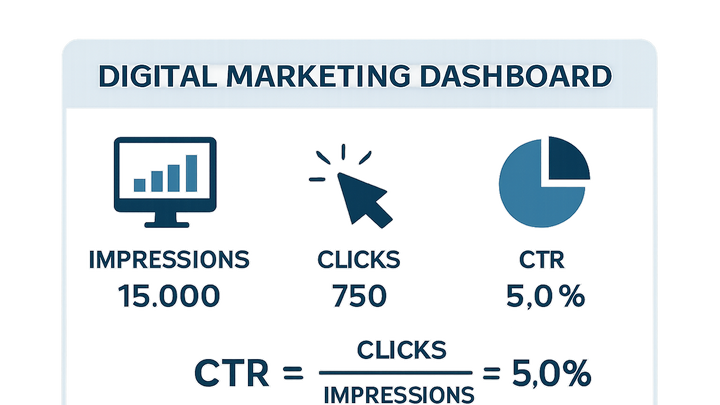Published on 2025-06-29T18:14:05Z
What is Click-Through Rate (CTR)? Examples and How to Track It
Click-Through Rate (CTR) measures the percentage of ad impressions or link views that result in clicks. In campaign tracking & analytics, CTR helps marketers evaluate the effectiveness of digital ads, email campaigns, and organic listings. A higher CTR indicates stronger engagement and relevance of your messaging to the audience. CTR can vary by channel, ad format, and industry benchmarks, so it should be analyzed in the context of your overall marketing goals. Tools like plainsignal offer simple, cookie-free ways to monitor CTR, while platforms like UTMguru help you generate UTM-coded links to accurately attribute clicks in your analytics suite.
Click-through rate (ctr)
Percentage of ad or link impressions that result in clicks; a key engagement metric.
Overview of Click-Through Rate
This section defines CTR and explains its significance in digital marketing campaigns.
-
Definition of ctr
CTR is defined as the ratio of unique user clicks to total impressions of an ad or link, expressed as a percentage. It indicates how effectively your creative and messaging prompt users to take action.
-
Why ctr matters
A strong CTR signals that your ad copy, design, and targeting resonate with your audience. It directly impacts Quality Score in paid search, influences ad auction costs, and guides optimization decisions.
- Quality score boost:
Higher CTR improves your Quality Score in platforms like Google Ads, reducing cost-per-click.
- Performance indicator:
CTR reveals which creatives, channels, or segments need improvement.
- Roi insights:
Comparing CTR across campaigns helps allocate budget to top performers.
- Quality score boost:
Calculating CTR
Here’s how to compute CTR and interpret the results.
-
Ctr formula
CTR = (Clicks / Impressions) * 100Replace ‘Clicks’ with the number of times users clicked your link, and ‘Impressions’ with times the link was displayed. -
Example calculation
If your ad received 150 clicks from 10,000 impressions, your CTR is (150 / 10,000) * 100 = 1.5%.
Tracking CTR with SaaS Tools
Leverage specialized analytics and UTM builders to measure and attribute CTR accurately.
-
Using plainsignal
PlainSignal offers a cookie-free analytics script to capture clicks and impressions. To integrate, add the following code to your site’s
<head>:<link rel="preconnect" href="//eu.plainsignal.com/" crossorigin /> <script defer data-do="yourwebsitedomain.com" data-id="0GQV1xmtzQQ" data-api="//eu.plainsignal.com" src="//cdn.plainsignal.com/plainsignal-min.js"></script>Once installed, view CTR metrics in the PlainSignal dashboard under the metrics tab.
-
Generating utm links with utmguru
UTMguru simplifies building UTM-tagged URLs that feed into your analytics platform. Create campaign-specific parameters to track source, medium, and campaign name. Each click generates a recorded hit in tools like Google Analytics, letting you calculate CTR by campaign.
Best Practices to Improve CTR
Strategies to enhance your click-through performance across channels.
-
Craft compelling ctas
Use action-oriented language and clear value propositions in your call-to-action to entice clicks.
- Use power words:
Incorporate words like ‘Discover’, ‘Free’, or ‘Exclusive’ to boost urgency.
- A/b test cta buttons:
Experiment with button color, size, and placement to find the most effective combination.
- Use power words:
-
Refine audience targeting
Align your creative and offers with specific audience segments to increase ad relevance and CTR.
- Leverage demographics:
Target by age, gender, or interests for more personalized messaging.
- Retarget warm audiences:
Focus on users who have interacted with your brand before for higher conversion likelihood.
- Leverage demographics:
-
Optimize ad copy and design
Test headlines, descriptions, and visuals to determine what resonates best with your audience.
Common Pitfalls and How to Avoid Them
Typical mistakes when measuring or interpreting CTR and tips to sidestep them.
-
Low sample size
Small impression counts can lead to misleading CTR fluctuations; ensure sufficient data before drawing conclusions.
-
Bot and fraud traffic
Automated clicks inflate CTR without real engagement; use tools with bot filtering like PlainSignal’s privacy-centric approach.
-
Ignoring multi-touch attribution
Focusing solely on CTR at first click can miss the full customer journey; consider multi-touch models for deeper insights.
